Projector screens: types and do-it-yourself manufacturing
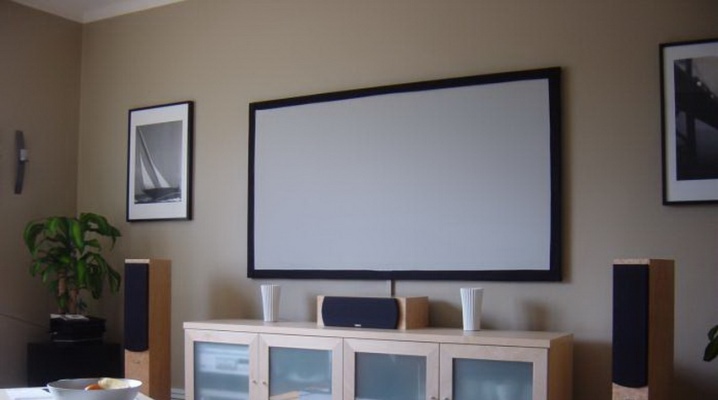
Projectors are widely used in the educational and work process for displaying the desired video material, and more recently they are used to create a home theater. The projection screen is a necessary accessory for displaying images.
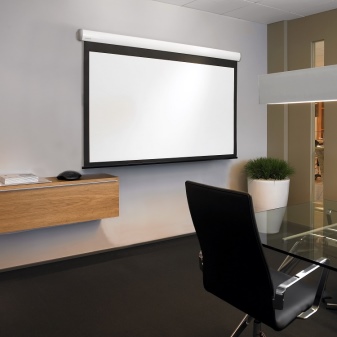
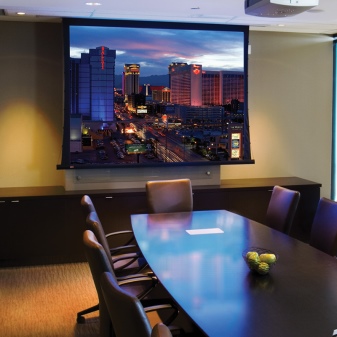
Features and requirements
The projector screen is designed to visually display the projected image. It consists of the following structural elements: a flat surface capable of scattering light and a support device. A special feature of a projection screen lies in its ability to reproduce optical images and direct the projected light towards the viewer. A high-quality image is achieved if the screen for a video projector meets these requirements.
- Have a high gain. This is an indicator of the ability of the screen fabric to reflect the light falling on it - the reflective ability. If it is low, then the image becomes dull and inexpressive. The brightest picture is obtained with a high ratio.
- Have the ability to evenly distribute the luminous flux over the entire area of the screen surface, that is, to have uniformity of the image.
- Have good contrast - accurately reproduce light and dark elements of the picture.
- The viewing angle is important, which defines the spatial zone in which the image is viewed most comfortably. It should be quite wide.
In addition, the screen surface must be flat, smooth and flat so that the picture is not distorted.



Species overview
Screens are classified into views depending on how they are installed, controlled and projected.
Portable
The advantage of this type is the ability to move and install the accessory in the desired room. Portable models, in turn, are subdivided into such varieties.
- 2-post model. It has good stability, height adjustment of the web by adjusting the length of the supports, but is too massive.
- A deployable roll-up version that is hung on the wall. Before viewing, the accessory is unrolled, and then rolled up again.
- The tripod screen is a fairly stable 3-post construction. It is considered the most convenient portable type and is characterized by ease of installation, small size and weight.
- Mobile desktop and floor options... The tube is placed on a table (floor), a screen fabric is pulled out of it, which is then fixed with a scissors-type fastening.


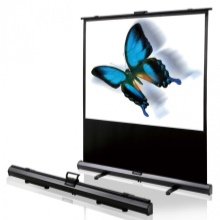
Stationary
This type of cloth is characterized by reliability and durability. There are these types of stationary screens.
- Tension - the canvas is first pulled over the frame, and then fixed on the wall. This wall-mounted version is always in the same place.
- Ceiling - the screen fabric is built into the ceiling. Such models are usually controlled by a motor and a remote control.
- Roll models - the case with the rolled-up screen is mounted on the wall. The upper mechanism unfolds the canvas, and the lower one fixes it in the unfolded state. These models can be easily expanded and re-collapsed as needed.


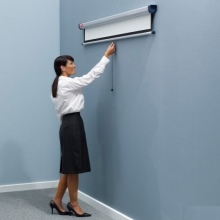
By the type of projection, the screen can be:
- frontal or direct projection - the projector is directly in front of the screen and reflects the light towards the audience;
- rear projection - the projector is behind the canvas;
- dual projection - forward and backward, where the projectors are on either side of the screen.
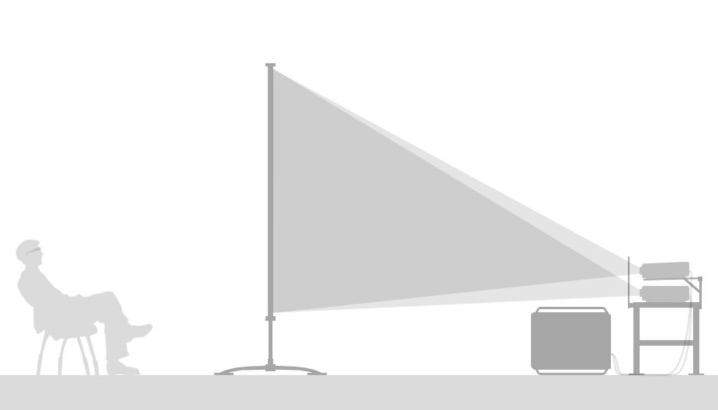
Types of canvases
The screen canvas is of different types.
- Matt white... Such a canvas provides a wide viewing angle and a clear image due to the uniform dispersion of the light flux, but requires complete darkening of the room.
- Gray screen... Gray color, improving contrast, adds dimension and scale to the picture.
However, the screen has less high reflective properties, and therefore it needs a stronger luminous flux.
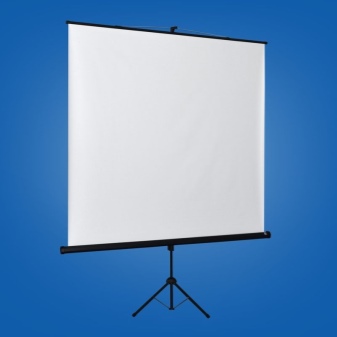

There is a variety of glossy coated gray screen. The model has a high contrast, which is achieved through a combination of absorbing gray pigment and a reflective glass or aluminized (in the form of aluminum powder) microelement.
- Glossy canvas... It has a high contrast ratio regardless of the power of the projector. However, reflections can occur on it when viewing, so absolute darkening is necessary.
- Projection film. This is a completely new technological solution. It can be translucent or completely dark, and can be glued to any base. The projection is made on both sides of it immediately after gluing.


Dimensions (edit)
The size and aspect of screens are important as they affect picture quality. The screen is measured in inches. The dimensions of wall-mounted and floor-standing mobile models can be very different - from 60 to 300 inches in diagonal. The choice of size depends primarily on the size of the room for watching video and the features of the projector. The size of the wall screen is chosen according to the following rule: its height should be 2 times less than the distance to the first row of spectators, and be 1/6 of the distance to the last row. Since each specific room has its own dimensions, the sizes of the screens will be different.
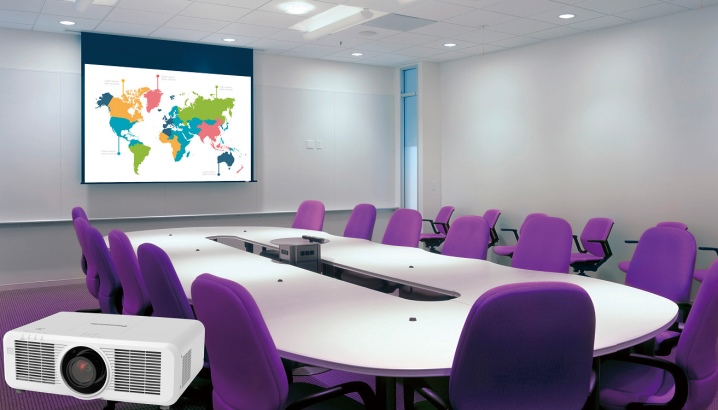
Aspect is the aspect ratio of the image (height to width)... The following formats are considered standard: 3: 4; 16: 9 and 2.35: 1. However, 1: 1 formats are most often used for video projection; 3: 4 and 16: 9. For home video viewing, the large format 16: 9 is better, and for the office, the 3: 4 format is most suitable.
For example, for a 16: 9 format with a 3.5-4m distance to the audience, a 150-120-inch wall screen is suitable. The dimensions of mobile floor-standing models are slightly smaller than wall-mounted ones. The size of the diagonals of floor standing models on a 1: 1 format tripod can range from 85 to 100 inches, and with a 3: 4 format - from 71 to 98 inches.


Control methods
There are such ways to control the screen canvas.
- Manual, in which both expanding and minimizing the screen are done manually. This is the most straightforward method of preparing an accessory for video viewing.
- Spring method. The design of the canvas has a special spring device, with the help of which the screen is lowered, and then securely fixed at the bottom. At the same time, the canvas has a very flat surface.
- Motorized (electric) method... Lifting and lowering of the web is carried out using a motor, which is controlled by a remote control.



Of all types, spring and manual control methods are considered the most reliable.
Rating of the best models
Often the quality of the screen depends on the manufacturer. The range of these products is widely represented, but the following companies are considered as undoubted authorities: CACTUS, LUMIEN, Digis Kontur, which produce products of various prices. Among the accessories of low cost (up to 10 thousand rubles), such models are the most popular.
Elite Screens Tripod - This is a portable screen view with a compact tripod support.The model with a wide viewing angle is versatile and is designed for viewing photos and films, digital graphs and diagrams. The image is distinguished by its brightness and color saturation.



- CACTUS Triscreen CS-PST. Another portable model on a compact tripod. The structure is easily and quickly assembled and dismantled. A front projection screen with a matte white canvas provides a bright, clear image with rich color.


Among the more expensive products such models can be noted.
Classic Solution Lyra E. The model can be used not only in the professional and educational process, but also for home theaters. The screen has a ceiling-wall installation, a roll-up structure with a spring mechanism and a control panel, and guarantees a high-quality bright image and a wide viewing angle.

- CACTUS Moto Expert CS-PSME. The ceiling / wall mount screen is versatile and has a very high performance: the 118 '' screen has a special anti-static and flame retardant coating. Excellent picture quality is guaranteed by a high gain of 10.


Other popular and high-quality models can also be noted: ELITE SCREENS Spectrum Electric - roll cloth with a motorized drive; LUMIEN Master Picture - with a canvas made of high quality polymer materials; CACTUS Wallscreen CS-PSW - a budget option for a wall screen.



How to choose?
Choosing a projection screen is a tricky business as it depends on many factors, primarily the area of application. The purpose of use affects the appearance of the screen. If it is assumed that the viewing will take place in the same room, then stationary models should be chosen. And if you need to move the canvas from one room to another, then the best option is portable models.
For home theater applications, roll-up models with side tension are recommended - they provide a smoother surface.


When choosing a screen, you should also consider such factors.
- Projector specifications... Projectors have different options and require certain types of screens. So, roll cloths with a 1: 1 and 4: 3 format are considered universal, they can be used for many types of projectors, even for a laser one.
- Canvas type. When choosing, you need to remember that the screen coating material affects the scattering of the light flux in a certain direction, and therefore the viewing angle. Screens with matte cloth are recommended.
- Indoor lighting... A direct projection screen is required in a room where lighting can be controlled. In high light conditions (offices, classrooms), a rear projection screen is recommended.
- The dimensions of the room. For spacious auditoriums, conference rooms, for stage mounting, stretch, stationary roll-up and projection screens within frames are the best option. For educational institutions and small offices, portable - floor and desktop models are quite suitable.
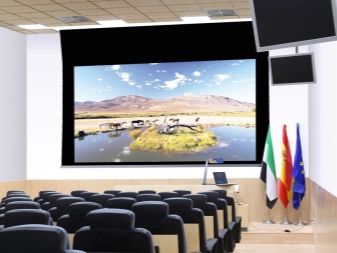

When choosing the aspect ratio and screen diagonal size, it is important that they match the dimensions of the projector image. It is recommended to choose a canvas with a diagonal slightly larger than the size of the projector image, otherwise the picture will go beyond the frame of the screen. Let's give some more tips.
- It is recommended to purchase a projector accessory in specialized departments or shops.
- Buy should be the model well-known and proven manufacturers.
- When buying, you need inspect the screen surface well (it must be free of defects), check the strength and reliability of the design of portable models and the operation of mechanisms in roll-up versions: they must work well and clearly.
- When choosing portable models on a tripod, we recommend metal constructions - they are more stable and practical than plastic ones.



Installation rules
There are some simple rules to follow when installing a projection screen.
- Determine the installation location of the blade, using the instructions in the attached instructions.
- Place the projector so that its lens is perpendicular to the vertical surface of the screen. This will allow you to quickly adjust the canvas and prevent video distortion.
- The distance from the floor to the underside of the canvas should be 60-90 cm.
- When mounting the screen on a wall, use only the supplied mounts as they have been factory tested for durability.
- There are special brackets for mounting to the ceiling, which are purchased separately.
- Installation of roll-up models is not particularly difficult - the tube is fixed with fasteners to the wall.
- When mounting the models on a tripod or stand, follow the step-by-step instructions that came with the product.
- Concealed installation of the screen is carried out in the ceiling recess, specially prepared for this. The screen body is mounted during finishing work, and the canvas itself is installed in the body after the work is completed.
Thus, in the non-working state, the canvas is completely hidden.



How to do it yourself?
Production projection screens are quite expensive. A homemade version will cost less and will differ in individual design for the interior.
Tools and materials
To work on the production of a projection surface, you need a certain set of tools and additional construction materials:
- matched screen fabric;
- wood bars of the appropriate size;
- aluminum profiles (boxes);
- metal corners for fixing frame elements;
- tape measure and construction stapler;
- lining material - non-thick felt, plastic wrap;
- drill-driver and self-tapping screws for wood;
- hanging loops;
- knife (construction) or scissors;
- sandpaper.


As a screen cover, you can use various materials with their own characteristics.
- Banner fabric - is a synthetic material and has high strength and good reflective properties. The material is distinguished by excellent resistance to mechanical damage and a low ability to transmit light, which guarantees a high-quality image.
- Vinyl. It is the vinyl screen covering that is considered standard. This material has the following properties: texture with good density, high contrast and light reflectance, and is well stretched. It is usually used for roll-up wall models. White vinyl fabric often has an extra layer that blocks light transmission.
- PVC film. Only matte film can be used for the screen. Additionally, a black polyethylene backing is required to make the screen less transparent and more dense. However, the material does not have sufficient strength to mechanical stress and needs careful handling.
- Raincoat fabric. This is a completely reliable and practical fabric that is easy to stretch and does not tear under the influence of tension, is resistant to moisture and dirt.
- Linen. Linen fabric and an ordinary linen sheet may well serve as a screen canvas. Flax has high strength and reflective properties, and to enhance them, you can additionally cover the screen with a white (matte) paint.
- Stretch ceiling fabric... The synthetic material has a matte gray texture. It is easily and well smoothed when pulled over the frame. However, due to the transparency, an additional black backing is required.
- Reflective fabric. It has enhanced reflective properties, which makes the image clear. But, having a lot of weight, such a structure requires reliable support.
- Fiberboard and drywall... Screens made from such improvised materials as fiberboard, drywall, and even ordinary plywood and whiteboard will not have a high image quality. Painting the surface with water-based matte paint will help to increase it.
- Special professional paint (screen paint) intended for the screen. The surface on which the paint is sprayed with a spray gun must be absolutely flat and smooth.



All materials have different costs: the cheapest are fiberboard and drywall, and the most expensive is screen paint.
Manufacturing scheme
A homemade screen can be made in several ways. One of the simplest options that does not require special designs is ordinary wall painting. The work is carried out as follows.
- Wall treatment. The wall surface must be absolutely flat and smooth. For this purpose, the plaster of the wall should be re-plastering, at the same time controlling the level of verticality and evenness of its surface. After that, the wall is covered with a primer paint to ensure the greatest smoothness.
- The choice of paint. The best option is to use a special paint screen. You can also use other cheaper types of paint: water-based paint, acrylic reflective paint for cars.
- Screen outline markup... The contours of the screen are applied to the surface of the wall using masking tape or a decorative frame.
- Painting the wall. When applying paint, you should adhere to the rule: you need to paint from top to bottom, applying vertical stripes with a roller or spray gun.

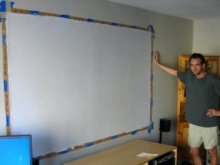

The image quality on such a screen will depend on the quality of the work performed and the paint. Another simple method is to make a projection screen from any kind of fabric or synthetic material. The work is carried out according to the following scheme.
Making the base frame
To achieve good blade tension, the frame must be sufficiently rigid. The simplest frame can be made from wooden blocks. Its design includes 5 elements: 4 bars form the perimeter, the fifth is an additional fixing element located between the longest sides of the frame. It protects the frame from skewing.
- First, all edges and cuts should be carefully sandpaper.
- The joints of the bars are fixed with corners using self-tapping screws.
- The finished structure is checked with a level for evenness.


Pulling the screen cloth
This work is recommended to be carried out on a surface with a soft base, for example, by placing felt or plastic wrap. The canvas is fixed to the finished frame as follows.
- You can start fixing from any angle.
- First, the slightly stretched fabric is secured with a stapler along the short side of the corner of the frame.
- Then the canvas, also slightly stretched, is fastened in opposite places on the other longer side of the corner, symmetrically to the already fixed side.
- Gradually moving to opposite edges, the canvas is fixed.
- In the same way, the fabric is fixed in the last corner on the other short side.
- At the end of the work, the excess fabric is cut with a knife (scissors).
- Loops (ears) for hanging are attached to the frame of the finished screen.




In the same way, you can make a screen with an aluminum profile frame.
See the following video on how to choose a screen for your projector.













The comment was sent successfully.